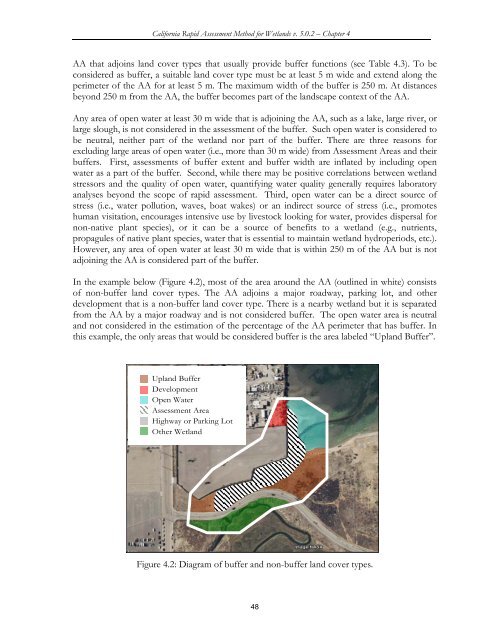(CRAM) For Wetlands User's Manual Version 5.0.2
(CRAM) For Wetlands User's Manual Version 5.0.2
(CRAM) For Wetlands User's Manual Version 5.0.2
You also want an ePaper? Increase the reach of your titles
YUMPU automatically turns print PDFs into web optimized ePapers that Google loves.
California Rapid Assessment Method for <strong>Wetlands</strong> v. <strong>5.0.2</strong> – Chapter 4<br />
AA that adjoins land cover types that usually provide buffer functions (see Table 4.3). To be<br />
considered as buffer, a suitable land cover type must be at least 5 m wide and extend along the<br />
perimeter of the AA for at least 5 m. The maximum width of the buffer is 250 m. At distances<br />
beyond 250 m from the AA, the buffer becomes part of the landscape context of the AA.<br />
Any area of open water at least 30 m wide that is adjoining the AA, such as a lake, large river, or<br />
large slough, is not considered in the assessment of the buffer. Such open water is considered to<br />
be neutral, neither part of the wetland nor part of the buffer. There are three reasons for<br />
excluding large areas of open water (i.e., more than 30 m wide) from Assessment Areas and their<br />
buffers. First, assessments of buffer extent and buffer width are inflated by including open<br />
water as a part of the buffer. Second, while there may be positive correlations between wetland<br />
stressors and the quality of open water, quantifying water quality generally requires laboratory<br />
analyses beyond the scope of rapid assessment. Third, open water can be a direct source of<br />
stress (i.e., water pollution, waves, boat wakes) or an indirect source of stress (i.e., promotes<br />
human visitation, encourages intensive use by livestock looking for water, provides dispersal for<br />
non-native plant species), or it can be a source of benefits to a wetland (e.g., nutrients,<br />
propagules of native plant species, water that is essential to maintain wetland hydroperiods, etc.).<br />
However, any area of open water at least 30 m wide that is within 250 m of the AA but is not<br />
adjoining the AA is considered part of the buffer.<br />
In the example below (Figure 4.2), most of the area around the AA (outlined in white) consists<br />
of non-buffer land cover types. The AA adjoins a major roadway, parking lot, and other<br />
development that is a non-buffer land cover type. There is a nearby wetland but it is separated<br />
from the AA by a major roadway and is not considered buffer. The open water area is neutral<br />
and not considered in the estimation of the percentage of the AA perimeter that has buffer. In<br />
this example, the only areas that would be considered buffer is the area labeled “Upland Buffer”.<br />
Upland Buffer<br />
Development<br />
Open Water<br />
Assessment Area<br />
Highway or Parking Lot<br />
Other Wetland<br />
Figure 4.2: Diagram of buffer and non-buffer land cover types.<br />
48















